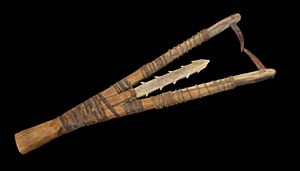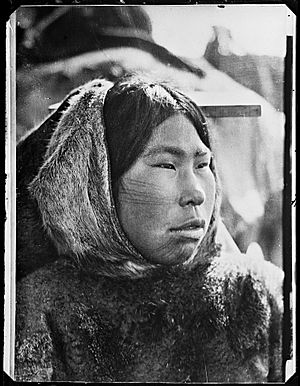Netsilik facts for kids
The Netsilik people are a group of Inuit who mostly live in Kugaaruk and Gjoa Haven. These towns are in the Kitikmeot Region of Nunavut, Canada. Some Netsilik also live in Taloyoak and the northern part of the Qikiqtaaluk Region. In the early 1900s, the Netsilik were among the last Indigenous groups in the North to meet missionaries from the south.
Contents
Netsilik Language and Writing
In the 1920s, missionaries brought a written language system to the Netsilik. This system is called Qaniujaaqpait. It uses symbols, or syllabics, to represent sounds. The Netsilik and other Eastern Canadian Inuit were the only Inuit to start using this type of writing.
The Netsilik speak their own language, which is called Natsilingmiutut. Another group, the Utkuhiksalingmiut, who are a type of Caribou Inuit, speak a similar language called Utkuhiksalik.
Surviving in the Arctic: Hunting and Fishing
The Arctic environment where the Netsilik lived was very harsh. Not many plants could grow there. Because of this, the Netsilik depended on hunting and fishing to get almost everything they needed to live.
Summer Hunting: Caribou
During the summer months, the Netsilik would hunt caribou on the tundra. Caribou were very important. They provided food for eating. Their hides were also used to make most of the Netsilik's clothing. Sometimes, if caribou skins were not available, polar bear skins were used instead.
Caribou antlers were also extremely useful. The Netsilik made many tools from these antlers. One important tool was a probe used to find breathing holes in the ice. This tool was key for seal hunting in winter.
Winter Life: Seals and Fish
In the colder winter months, the Netsilik would move out onto the sea ice. Here, they would fish and hunt seals. Seals were a vital resource. They provided fat for the Netsilik's kudlik lamps. These soapstone lamps lit and heated their igloos. This meant the Netsilik, like many other Inuit, hunted for their heating fuel instead of using wood.

Fish were another important food source for the Netsilik. They would fish for Arctic char when seals and caribou were hard to find. They used a tool called a kakivak to spear fish through holes in the ice. Any extra fish were kept in blocks of ice. This way, they could save food for times when hunting and fishing were not successful.
Changes in Netsilik Culture
By 1923, the Netsilik began to use firearms. Iron and steel also started to replace older tools made from flint and bone. These new materials were used for arrowheads, harpoons, needles, and knives. This made hunting much easier for the Netsilik people.
From the 1930s to the 1960s, Christian missionaries and the Canadian government became more involved in the lives of the Netsilik. The Netsilik started trading fox pelts. This helped them earn money to buy goods from other places.
Changes happened faster in the 1960s. More and more Netsilik people became Christian. They also started moving into permanent homes built with new materials. Many began to work for wages and use government services. Today, most Netsilik do not live in the traditional ways of hunting and gathering. However, some elders still create traditional items. These include kayaks and stone tools. They make these for museums or to sell.
Netsilik in Arts and Education
In the 1970s, the Netsilik people were part of a U.S. educational project called Man: A Course of Study. This project aimed to teach students about different cultures.
In 1988, parts of Knud Rasmussen's Journals of the Fifth Thule Expedition were used by composer Raymond Luedeke. He created an orchestral music piece with narration called Tales of the Netilik. This music was played by six Canadian orchestras across Canada.


